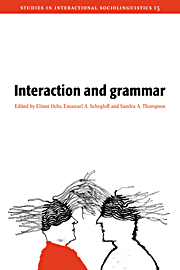Book contents
- Frontmatter
- Contents
- Notes on the contributors
- 1 Introduction
- 2 Turn organization: one intersection of grammar and interaction
- 3 Interactional units in conversation: syntactic, intonational, and pragmatic resources for the management of turns
- 4 Resources and repair: a cross-linguistic study of syntax and repair
- 5 On the “semi-permeable” character of grammatical units in conversation: conditional entry into the turn space of another speaker
- 6 On repeats and responses in Finnish conversations
- 7 “When I come down I'm in the domain state”: grammar and graphic representation in the interpretive activity of physicists
- 8 Transparent vision
- 9 Conversational signifying: grammar and indirectness among African American women
- 10 Creating evidence: making sense of written words in Bosavi
- Appendix Transcription conventions
- Index
7 - “When I come down I'm in the domain state”: grammar and graphic representation in the interpretive activity of physicists
Published online by Cambridge University Press: 14 January 2010
- Frontmatter
- Contents
- Notes on the contributors
- 1 Introduction
- 2 Turn organization: one intersection of grammar and interaction
- 3 Interactional units in conversation: syntactic, intonational, and pragmatic resources for the management of turns
- 4 Resources and repair: a cross-linguistic study of syntax and repair
- 5 On the “semi-permeable” character of grammatical units in conversation: conditional entry into the turn space of another speaker
- 6 On repeats and responses in Finnish conversations
- 7 “When I come down I'm in the domain state”: grammar and graphic representation in the interpretive activity of physicists
- 8 Transparent vision
- 9 Conversational signifying: grammar and indirectness among African American women
- 10 Creating evidence: making sense of written words in Bosavi
- Appendix Transcription conventions
- Index
Summary
“I” is not the name of a person, nor “here” of a place, and “this” is not a name. But they are connected with names. Names are explained by means of them. It is also true that it is characteristic of physics not to use these words.
L. Wittgenstein, Philosophical Investigations (1958: 123)Linguistic resources for practicing science
This paper explores how scientists build meaning through routine interpretive activity involving talk, gesture, and graphic representation. In the course of making sense of their own and others' scientific research, scientists sometimes combine these semiotic resources in ways that seem to blur the distinction between scientist and the physical world under scrutiny. We shall argue in this paper that in scientific interaction, (1) grammar works together with graphic representation and gesture to construct a referential identity which is both animate and inanimate, subject and object, and that (2) the construction of this indeterminate referential identity plays an important role in scientists' efforts to achieve mutual understanding and arrive at a working consensus.
Our study is intended to be of cross-disciplinary interest. The analysis is motivated by cultural, philosophical, sociological, and historical research on scientific practice (e.g., Bloor, 1976; Lynch, 1985, 1993; Shapin and Schaffer, 1985; Pickering, 1992; Biagioli, 1993); anthropological and linguistic approaches to lexical and grammatical structure (e.g., Duranti, 1990; Hanks, 1990, 1992; Silverstein, 1993); interactional studies of conversational discourse (e.g., Schegloff, 1991; Goodwin, 1994); and psychological paradigms that take activity as a locus of human cognition (e.g., Voloshinov, 1973; Vygotsky, 1978; Leontyev, 1981; Bakhtin, 1993).
- Type
- Chapter
- Information
- Interaction and Grammar , pp. 328 - 369Publisher: Cambridge University PressPrint publication year: 1996
- 171
- Cited by



